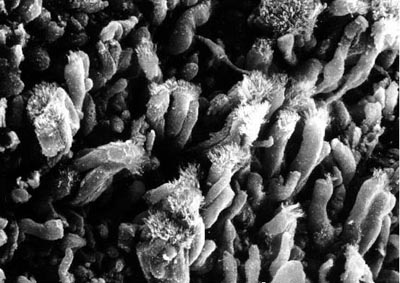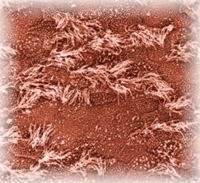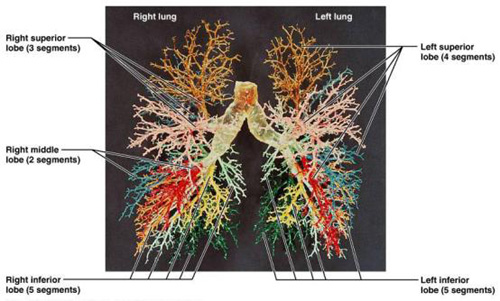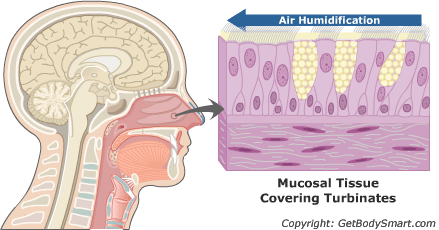The Main Roles of the Turbinates
- To direct and maintain laminar airflow, respiratory rate and velocity
- Air Conditioning (Humidification + Heating)
- Filtration
- Olfaction
Air Conditioning (Humidification + Heating):
Humidification: The most important function of the nose is to humidify and heat the inspired air for its entrance into the trachea, bronchi and lungs. The atmosphere varies in temperature, relative humidity, and cleanliness. Whether the outside air is 40ºC in the shade or 10ºC below zero, and with only 30% humidity, the air that is inspired through the nose will be heated to just under normal body temperature (31 – 33ºC) and close to about 98% humidity. By the time this air enters the larynx, the rest of the respiratory tracts haven’t got much more to do. The thoracic additional air-conditioning completes the temperature rise to 37ºC and the humidity rise to 100% by the time the air enters the lungs.

Fig 23: Distribution of Temperature and Humidity.
As the lungs rely totally on positive pressurized steady airflow and high dynamic air pressure values of sucked in inspired air to inflate them, the air must be very humid and warm – or the fine narrow tubes (the bronchioles and the alveoli) might not get inflated properly, or not get inflated at all at the most remote ends of the lungs. If proper lung inflation is denied chronically – this can result after some years into a life threatening lung disease called Emphysema. Humidification is also crucial for sustaining the integrity and survival of the cilia blanket’s hairy layer, which covers the entire respiratory tracts, including the nose. One-hundred and fifty to three hundred cilia are present in each cell, they are covered by a blanket of mucus that catches particles. The cilia beats in a rhythmic and uniform manner, moving the mucus gel layer to the back of the nose, into the nasopharynx. Cilia cells are durable; they are able to resist cold, heat, smoke, and even infection. However, they have one deadly enemy: dryness.

Fig 24: Normal healthy Cilia – layer

Fig 25: Damaged cilia layer.
Just to emphasize the importance of breathing in humidified air: Many fire survivors who have inhaled large amounts of smoke – get the protective cilia layer damaged because of extreme dryness. As a result, the cilia can no longer effectively “beat” out the mucus and, together with the debris and air-born particles, the lungs get flooded with mucus, and alien un-filtrated particles. They can cause pneumonia. Many of those smoke-injured fire survivors later die from pneumonia complications.
And finally – highly humidified and warm air (heated to body temperature) is crucial for proper gas exchange to take place between the pulmonary capillaries in the alveoli and the surrounding blood net of arteries and veins, receiving oxygen through membranic diffusion and passing out the waste – the carbon dioxide in the same way. The membranic diffusion of the gasses is aided by being saturated in high humidity and body heat temperature conditions in the alveoli sucks, where the exchange occurs. If these conditions are not met, the alveoli cannot inflate properly and simply shut down, just like in a severe attack of asthma.

Fig 26: Bronchiole tree in lungs.
How Humidification Occurs
The mucus gel watery layer, that is secreted from the goblet cells (see figures – 11b’ and 12) from deep in the pseudostratified columnar epithelium layer (beneath the cilia), forms a kind of watery moving layer on top of the cilia blanket. As the inspired air passes over it, it gets saturated and humidified.

Fig 27: Normal Turbinate Tissue.
Inspired air comes into contact with the warm and moist nasal mucosa and is rapidly warmed and humidified. During expiration, some of the heat and water are returned to the nasal walls. The nose is an extremely effective air-conditioner. It reaches optimal heat and humidification in a split of a second. For example, in a pleasant environment of 23ºC and 40% relative humidity, inhaled air is warmed to 33ºC and humidified to 98% relative humidity before reaching the glottis. The humidification process requires around 1 liter of mucus per day. The turbinates also act as humidity retainers, when during exhalation they capture some of the exhaled humidity, to prevent dehydration – which can occur more easily after a turbinectomy. In mammals, the retention of water by the turbinates is more effective than in humans: The camel, for example, through very well developed sets of turbinates, manages to retain most of the water in exhalation that it uses to humidify inspiration. That is one of the mechanisms that allows it to survive in extreme desert temperatures with no water for a long time.
Conclusion: The Nose is the air-conditioner and filter of the lungs, mainly thanks to the Turbinates that are made up of extremely rich and vascularised nasal mucosing tissue. Without the humidity supplied from the nose:
- the lungs cannot inflate to their maximum capacity.
- the gasses exchanged at the end of the breathing process (in the alveoli) will not exchange fast enough or to their fullest potential.
- extensive damage is created to the respiratory epithelium of the respiratory system – primarily starting in the nose. The first layer to get damaged is the “Cilia”. Dryness means – death to the cilia! Death to the cilia means a dramatic reduction in mucus secretions, and no mucociliary transport of the dried up mucus and debris.
- the turbinates with, their large volume of mucosing tissue, and with their role as the airflow regulators of the nose – are essentially the “heart” and “engine” of the nose, and supply the most critical mass of humidifying heat exchanging mucosa in the nose. This is a fact that any surgeon planning to cut out any portion of turbinate mucosa must take into account, and try and preserve as much as possible of it. A lifetime of a dry nose can lead to further damage to the cilia down the trachea and even in the lungs, as they get overtaxed – with having to humidify and clean themselves. This can lead to many respiratory and lung infections and eventually to life threatening complications of Chronic Pulmonary Disorders. The nose is the Guardian of the Lungs.